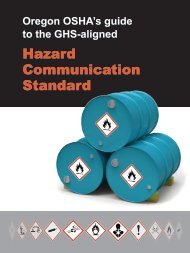Technical Manual - Section 3 (Safety Hazards)
Technical Manual - Section 3 (Safety Hazards)
Technical Manual - Section 3 (Safety Hazards)
You also want an ePaper? Increase the reach of your titles
YUMPU automatically turns print PDFs into web optimized ePapers that Google loves.
HYDROFORMING Catalytic reforming of naphtha at<br />
elevated temperatures and moderate pressures in the presence<br />
of hydrogen to form high-octane BTX aromatics for motor<br />
fuel or chemical manufacture. This process results in a net<br />
production of hydrogen and has rendered thermal reforming<br />
somewhat obsolete. It represents the total effect of numerous<br />
simultaneous reactions such as cracking, polymerization,<br />
dehydrogenation, and isomerization.<br />
HYDROGENATION The chemical addition of hydrogen to<br />
a material in the presence of a catalyst.<br />
INHIBITOR Additive used to prevent or retard undesirable<br />
changes in the quality of the product, or in the condition of<br />
the equipment in which the product is used.<br />
ISOMERIZATION A reaction that catalytically converts<br />
straight-chain hydrocarbon molecules into branched-chain<br />
molecules of substantially higher octane number. The<br />
reaction rearranges the carbon skeleton of a molecule without<br />
adding or removing anything from the original material.<br />
ISO-OCTANE A hydrocarbon molecule<br />
(2,2,4-trimethylpentane) with excellent antiknock<br />
characteristics on which the octane number of 100 is based.<br />
KNOCKOUT DRUM A vessel wherein suspended liquid is<br />
separated from gas or vapor.<br />
LEAN OIL Absorbent oil fed to absorption towers in which<br />
gas is to be stripped. After absorbing the heavy ends from the<br />
gas, it becomes fat oil. When the heavy ends are subsequently<br />
stripped, the solvent again becomes lean oil.<br />
LOW-LINE or LOW-PRESSURE GAS Low-pressure (5<br />
psi) gas from atmospheric and vacuum distillation recovery<br />
systems that is collected in the gas plant for compression to<br />
higher pressures.<br />
NAPHTHENES Hydrocarbons (cycloalkanes) with the<br />
general formula CnH2n, in which the carbon atoms are<br />
arranged to form a ring.<br />
OCTANE NUMBER A number indicating the relative<br />
antiknock characteristics of gasoline.<br />
OLEFINS A family of unsaturated hydrocarbons with one<br />
carbon-carbon double bond and the general formula CnH2n.<br />
PARAFFINS A family of saturated aliphatic hydrocarbons<br />
(alkanes) with the general formula CnH2n+2.<br />
POLYFORMING The thermal conversion of naphtha and<br />
gas oils into high-quality gasoline at high temperatures and<br />
pressure in the presence of recirculated hydrocarbon gases.<br />
POLYMERIZATION The process of combining two or<br />
more unsaturated organic molecules to form a single (heavier)<br />
molecule with the same elements in the same proportions as<br />
in the original molecule.<br />
PREHEATER Exchanger used to heat hydrocarbons before<br />
they are fed to a unit.<br />
PRESSURE-REGULATING VALVE A valve that releases<br />
or holds process-system pressure (that is, opens or closes)<br />
either by preset spring tension or by actuation by a valve<br />
controller to assume any desired position between fully open<br />
and fully closed.<br />
PYROLYSIS GASOLINE A by-product from the<br />
manufacture of ethylene by steam cracking of hydrocarbon<br />
fractions such as naphtha or gas oil.<br />
PYROPHORIC IRON SULFIDE A substance typically<br />
formed inside tanks and processing units by the corrosive<br />
NAPHTHA A general term used for low boiling<br />
hydrocarbon fractions that are a major component of<br />
gasoline. Aliphatic naphtha refers to those naphthas<br />
containing less than 0.1% benzene and with carbon numbers<br />
from C3 through C16. Aromatic naphthas have carbon<br />
numbers from C6 through C16 and contain significant<br />
quantities of aromatic hydrocarbons such as benzene<br />
(>0.1%), toluene, and xylene.<br />
III:2-62
















